Tajuddin Manhar Mohammed
MalGrid: Visualization Of Binary Features In Large Malware Corpora
Nov 04, 2022



Abstract:The number of malware is constantly on the rise. Though most new malware are modifications of existing ones, their sheer number is quite overwhelming. In this paper, we present a novel system to visualize and map millions of malware to points in a 2-dimensional (2D) spatial grid. This enables visualizing relationships within large malware datasets that can be used to develop triage solutions to screen different malware rapidly and provide situational awareness. Our approach links two visualizations within an interactive display. Our first view is a spatial point-based visualization of similarity among the samples based on a reduced dimensional projection of binary feature representations of malware. Our second spatial grid-based view provides a better insight into similarities and differences between selected malware samples in terms of the binary-based visual representations they share. We also provide a case study where the effect of packing on the malware data is correlated with the complexity of the packing algorithm.
OMD: Orthogonal Malware Detection Using Audio, Image, and Static Features
Nov 08, 2021

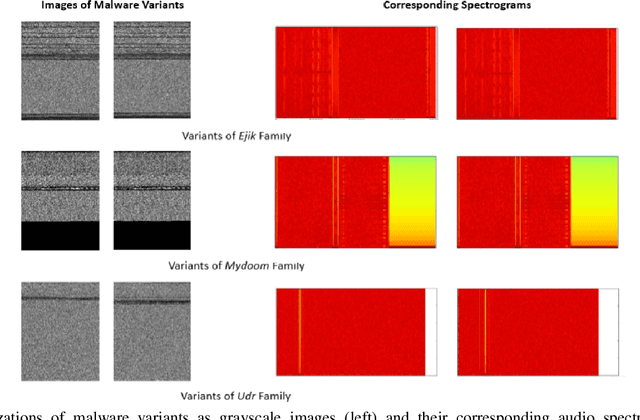
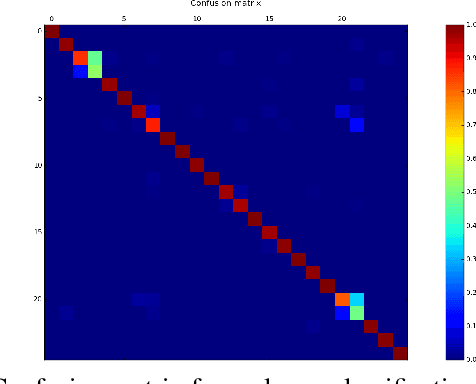
Abstract:With the growing number of malware and cyber attacks, there is a need for "orthogonal" cyber defense approaches, which are complementary to existing methods by detecting unique malware samples that are not predicted by other methods. In this paper, we propose a novel and orthogonal malware detection (OMD) approach to identify malware using a combination of audio descriptors, image similarity descriptors and other static/statistical features. First, we show how audio descriptors are effective in classifying malware families when the malware binaries are represented as audio signals. Then, we show that the predictions made on the audio descriptors are orthogonal to the predictions made on image similarity descriptors and other static features. Further, we develop a framework for error analysis and a metric to quantify how orthogonal a new feature set (or type) is with respect to other feature sets. This allows us to add new features and detection methods to our overall framework. Experimental results on malware datasets show that our approach provides a robust framework for orthogonal malware detection.
HAPSSA: Holistic Approach to PDF Malware Detection Using Signal and Statistical Analysis
Nov 08, 2021
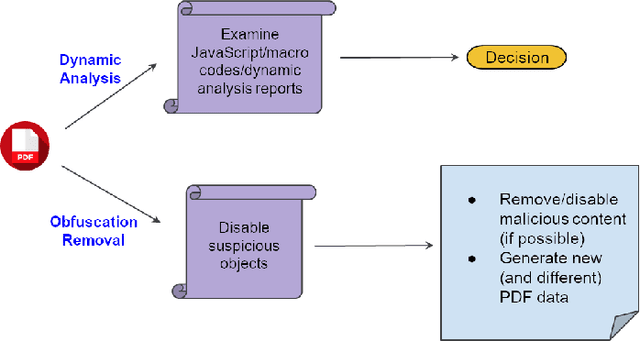
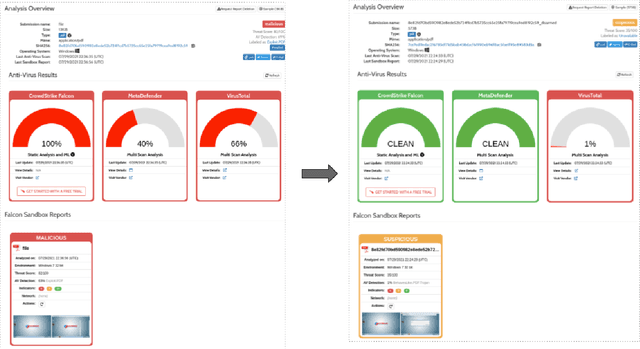
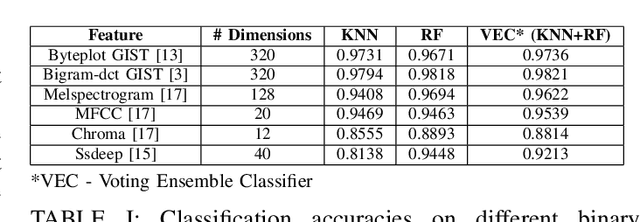
Abstract:Malicious PDF documents present a serious threat to various security organizations that require modern threat intelligence platforms to effectively analyze and characterize the identity and behavior of PDF malware. State-of-the-art approaches use machine learning (ML) to learn features that characterize PDF malware. However, ML models are often susceptible to evasion attacks, in which an adversary obfuscates the malware code to avoid being detected by an Antivirus. In this paper, we derive a simple yet effective holistic approach to PDF malware detection that leverages signal and statistical analysis of malware binaries. This includes combining orthogonal feature space models from various static and dynamic malware detection methods to enable generalized robustness when faced with code obfuscations. Using a dataset of nearly 30,000 PDF files containing both malware and benign samples, we show that our holistic approach maintains a high detection rate (99.92%) of PDF malware and even detects new malicious files created by simple methods that remove the obfuscation conducted by malware authors to hide their malware, which are undetected by most antiviruses.
Seam Carving Detection and Localization using Two-Stage Deep Neural Networks
Sep 04, 2021



Abstract:Seam carving is a method to resize an image in a content aware fashion. However, this method can also be used to carve out objects from images. In this paper, we propose a two-step method to detect and localize seam carved images. First, we build a detector to detect small patches in an image that has been seam carved. Next, we compute a heatmap on an image based on the patch detector's output. Using these heatmaps, we build another detector to detect if a whole image is seam carved or not. Our experimental results show that our approach is effective in detecting and localizing seam carved images.
Holistic Image Manipulation Detection using Pixel Co-occurrence Matrices
Apr 12, 2021



Abstract:Digital image forensics aims to detect images that have been digitally manipulated. Realistic image forgeries involve a combination of splicing, resampling, region removal, smoothing and other manipulation methods. While most detection methods in literature focus on detecting a particular type of manipulation, it is challenging to identify doctored images that involve a host of manipulations. In this paper, we propose a novel approach to holistically detect tampered images using a combination of pixel co-occurrence matrices and deep learning. We extract horizontal and vertical co-occurrence matrices on three color channels in the pixel domain and train a model using a deep convolutional neural network (CNN) framework. Our method is agnostic to the type of manipulation and classifies an image as tampered or untampered. We train and validate our model on a dataset of more than 86,000 images. Experimental results show that our approach is promising and achieves more than 0.99 area under the curve (AUC) evaluation metric on the training and validation subsets. Further, our approach also generalizes well and achieves around 0.81 AUC on an unseen test dataset comprising more than 19,740 images released as part of the Media Forensics Challenge (MFC) 2020. Our score was highest among all other teams that participated in the challenge, at the time of announcement of the challenge results.
Malware Detection Using Frequency Domain-Based Image Visualization and Deep Learning
Jan 26, 2021



Abstract:We propose a novel method to detect and visualize malware through image classification. The executable binaries are represented as grayscale images obtained from the count of N-grams (N=2) of bytes in the Discrete Cosine Transform (DCT) domain and a neural network is trained for malware detection. A shallow neural network is trained for classification, and its accuracy is compared with deep-network architectures such as ResNet that are trained using transfer learning. Neither dis-assembly nor behavioral analysis of malware is required for these methods. Motivated by the visual similarity of these images for different malware families, we compare our deep neural network models with standard image features like GIST descriptors to evaluate the performance. A joint feature measure is proposed to combine different features using error analysis to get an accurate ensemble model for improved classification performance. A new dataset called MaleX which contains around 1 million malware and benign Windows executable samples is created for large-scale malware detection and classification experiments. Experimental results are quite promising with 96% binary classification accuracy on MaleX. The proposed model is also able to generalize well on larger unseen malware samples and the results compare favorably with state-of-the-art static analysis-based malware detection algorithms.
Detection, Attribution and Localization of GAN Generated Images
Jul 20, 2020

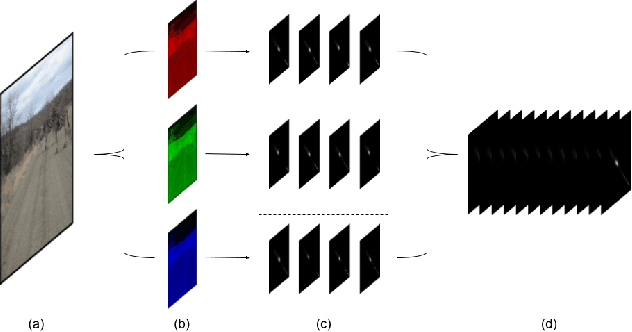

Abstract:Recent advances in Generative Adversarial Networks (GANs) have led to the creation of realistic-looking digital images that pose a major challenge to their detection by humans or computers. GANs are used in a wide range of tasks, from modifying small attributes of an image (StarGAN [14]), transferring attributes between image pairs (CycleGAN [91]), as well as generating entirely new images (ProGAN [36], StyleGAN [37], SPADE/GauGAN [64]). In this paper, we propose a novel approach to detect, attribute and localize GAN generated images that combines image features with deep learning methods. For every image, co-occurrence matrices are computed on neighborhood pixels of RGB channels in different directions (horizontal, vertical and diagonal). A deep learning network is then trained on these features to detect, attribute and localize these GAN generated/manipulated images. A large scale evaluation of our approach on 5 GAN datasets comprising over 2.76 million images (ProGAN, StarGAN, CycleGAN, StyleGAN and SPADE/GauGAN) shows promising results in detecting GAN generated images.
Detecting GAN generated Fake Images using Co-occurrence Matrices
Mar 15, 2019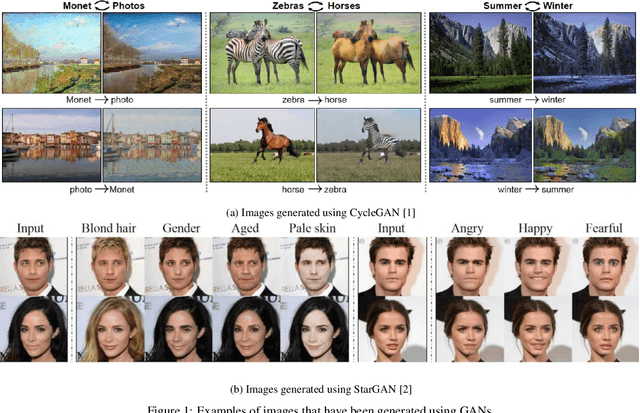
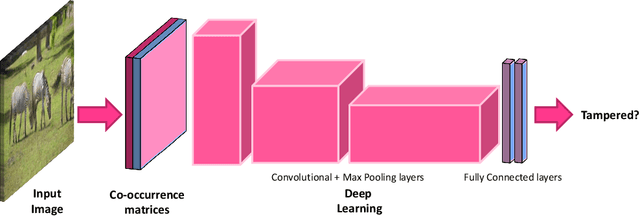


Abstract:The advent of Generative Adversarial Networks (GANs) has brought about completely novel ways of transforming and manipulating pixels in digital images. GAN based techniques such as Image-to-Image translations, DeepFakes, and other automated methods have become increasingly popular in creating fake images. In this paper, we propose a novel approach to detect GAN generated fake images using a combination of co-occurrence matrices and deep learning. We extract co-occurrence matrices on three color channels in the pixel domain and train a model using a deep convolutional neural network (CNN) framework. Experimental results on two diverse and challenging GAN datasets comprising more than 56,000 images based on unpaired image-to-image translations (cycleGAN [1]) and facial attributes/expressions (StarGAN [2]) show that our approach is promising and achieves more than 99% classification accuracy in both datasets. Further, our approach also generalizes well and achieves good results when trained on one dataset and tested on the other.
Resampling Forgery Detection Using Deep Learning and A-Contrario Analysis
Mar 01, 2018



Abstract:The amount of digital imagery recorded has recently grown exponentially, and with the advancement of software, such as Photoshop or Gimp, it has become easier to manipulate images. However, most images on the internet have not been manipulated and any automated manipulation detection algorithm must carefully control the false alarm rate. In this paper we discuss a method to automatically detect local resampling using deep learning while controlling the false alarm rate using a-contrario analysis. The automated procedure consists of three primary steps. First, resampling features are calculated for image blocks. A deep learning classifier is then used to generate a heatmap that indicates if the image block has been resampled. We expect some of these blocks to be falsely identified as resampled. We use a-contrario hypothesis testing to both identify if the patterns of the manipulated blocks indicate if the image has been tampered with and to localize the manipulation. We demonstrate that this strategy is effective in indicating if an image has been manipulated and localizing the manipulations.
Boosting Image Forgery Detection using Resampling Features and Copy-move analysis
Feb 19, 2018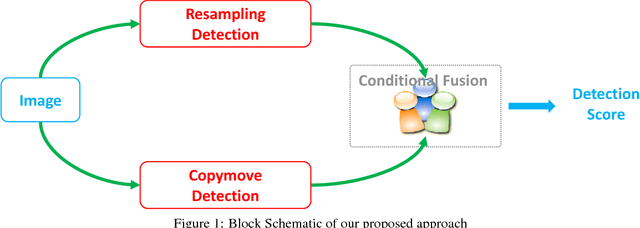
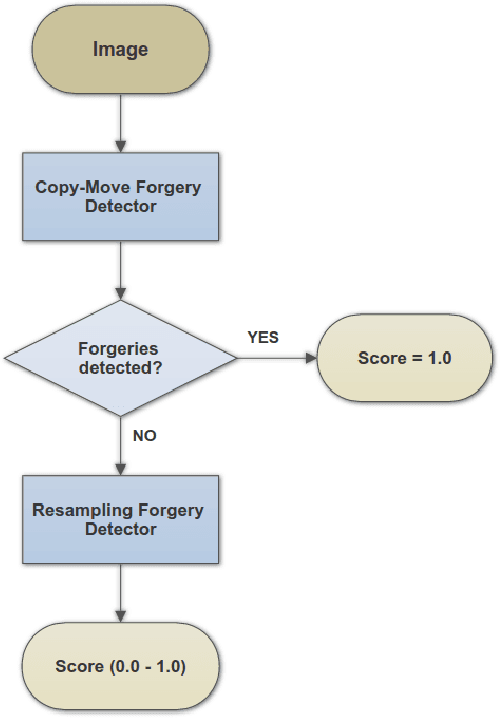

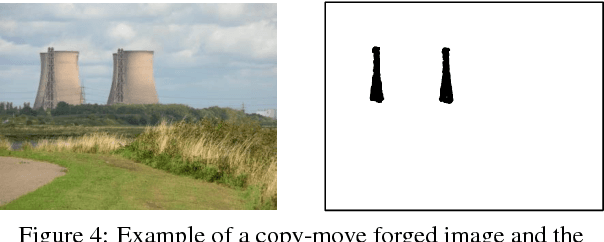
Abstract:Realistic image forgeries involve a combination of splicing, resampling, cloning, region removal and other methods. While resampling detection algorithms are effective in detecting splicing and resampling, copy-move detection algorithms excel in detecting cloning and region removal. In this paper, we combine these complementary approaches in a way that boosts the overall accuracy of image manipulation detection. We use the copy-move detection method as a pre-filtering step and pass those images that are classified as untampered to a deep learning based resampling detection framework. Experimental results on various datasets including the 2017 NIST Nimble Challenge Evaluation dataset comprising nearly 10,000 pristine and tampered images shows that there is a consistent increase of 8%-10% in detection rates, when copy-move algorithm is combined with different resampling detection algorithms.
 Add to Chrome
Add to Chrome Add to Firefox
Add to Firefox Add to Edge
Add to Edge